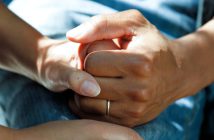What Exactly Is Impacted Earwax?
Cerumen, most commonly known as earwax, is a waxy yellowish-brown substance that coats the inside of our ear canal, a pathway running from the eardrum to the outer ear. Earwax acts as a protective barrier against water, bacterial and fungal infection, insects, dirt and other foreign objects. While it is necessary, too much earwax can build up, firmly wedge itself in and cause complications. This kind of packed buildup is known as impacted earwax.
Earwax is formed by combining secretions of two different glands inside the ear canal with shed skin cells. Skin cell migration slowly, but steadily, moves the earwax toward the outer part of the ear in a process similar to the conveyor belt, which is also assisted by jaw movement. Gradually, the earwax is transported all the way from the eardrum to the exit, where it eventually dries up.
This is a natural and self-regulating process, but occasionally some things interfere with it and cause problems. Some people produce more earwax than others and too much earwax can build up inside the canal and form a blockage. This is not always the case; most people experience just a small buildup which does not completely block the ear canal and will not cause any symptoms whatsoever.
Impacted earwax is not uncommon, especially with older age. Earwax generally becomes harder and less mobile over the years, which means that individuals in the older age group are more likely to experience problems with excess earwax.
What Is the Cause of Impacted Earwax?
Earwax buildups occur when your body produces earwax at a faster rate than it can expel it. Certain medical conditions also cause impacted earwax:
- Skin inflammation diseases like dermatitis
- Bacterial or fungal infection such as otitis externa (swimmer’s ear)
- Certain autoimmune diseases
- Bone growth like exostosis or osteoma
- Narrowed ear canal due to Down syndrome, injury or chronic inflammation
Some of the listed conditions cause a surplus production of earwax, while others result in a physical obstacle. There are also cases where the cause of impacted earwax is unknown.
Inserting objects into your ear canal can also cause earwax buildups, either because it stimulates earwax secretion, or because of unsuccessful attempts to manually remove the earwax, as is often the case with cotton swabs. Instead of removing the wax, you push it deeper inside the ear canal. On the other hand, repeated use of in-ear headphones, hearing aids and swimming plugs increases earwax production, which can lead to impaction.
To summarize, people with the above-mentioned medical conditions are at a higher risk of developing an earwax buildup. Older adults are in the increased risk group due to earwax changing with age and common use of medical implements such as hearing aids. People who suffer from cognitive impairment also experience impacted earwax at a higher than average rate, which only exacerbates the condition. An estimated 30% of the elderly and people with developmental disability have earwax-related problems.
Symptoms of Earwax Impaction
Earwax does not cause any symptoms under normal circumstances, because our ears naturally clean themselves. Symptoms only appear in case of a sizable buildup, which happens gradually. You might only experience some of the symptoms and not all at once. The most common signs of an earwax blockage are hearing difficulties or hearing loss, pressure sensation, ringing or tinnitus, ear pain, irritation and itching in the ear, spells of dizziness and coughing. The symptoms may seem similar to other medical conditions and it is strongly recommended to visit your doctor to correctly identify the problem.
How to Diagnose Impacted Earwax?
Your general physician or your healthcare provider can determine you have impacted earwax by performing a physical exam and looking through your health history. Physical exam generally consists of the doctor inspecting your ear with an instrument called otoscope, which enables them to have a thorough look inside your ear canal, and some additional simple hearing tests.
The doctor can diagnose impacted earwax even in the absence of usual symptoms. If they are unable to perform an otoscope inspection because the excess earwax obstructs their view, they might diagnose you with such a condition. Identifying impacted earwax may also be the result of an otherwise unrelated ear exam.
How to Treat Impacted Earwax?
Treatment of impacted earwax varies depending on the symptoms you display, your age, general health and the severity of the condition. If you display one or several of the usual symptoms, your doctor will recommend removing the earwax. On the other hand, if no symptoms are present, it is not necessary to undergo treatment, as our ears usually take care of the problem themselves without any intervention on our part. Also, in rare cases, some complications may occur when removing the excess earwax.
Your healthcare provider might, despite the lack of symptoms, perform some kind of treatment or earwax removal, in cases when an ear exam is necessary for different reasons and the impacted earwax is interfering with their examination. The doctor will also likely remove the earwax when patients, such as young children, have difficulty communicating their condition
The most common methods of treating impacted earwax are:
- Earwax solvents, usually in the form of ear drops that soften the wax and make is easier to dislodge.
- Ear irrigation, performed at the doctor’s office by irrigating your ear canal using a water streaming tool.
- Manual removal of the earwax using specialized curettes.
You can find the full list of ear wax remover tools here: https://www.diyhappy.com/ear-wax-removal-tool/
There is no single most effective method to treat impacted earwax. Your doctor will choose a method or a combination of them depending on the situation at hand and your health condition. Some medical conditions, such as inserted ear tubes, prevent the doctor from using a certain method, ear irrigation in this case.
There are also some methods of earwax removal, that people attempt at home. Cotton swabs might seem a simple way of dealing with earwax, but in reality, usually make matters worse by pushing the wax deeper inside the ear canal instead of removing it. Ear candling should also be avoided, as it is ineffective and you risk serious burn damage by using it. You can read more about the safe ear wax removal tools and techniques on diyhappy.com who not only provide a deep insights into different removal options but also show how to do it right.
Side Effects of Treating Impacted Earwax
Removing earwax is generally a safe and routine procedure, that causes no complications. In rare cases, some problems might occur when treating impacted earwax:
- Ear pain
- Spells of dizziness
- Ringing in the ears
- Water retention in the ear canal
- Temporary hearing loss
- Otitis externa (Swimmer’s Ear)
- Ruptured eardrum
Different treatment methods carry different risks because of techniques and implements involved. Certain medical conditions also increase the likelihood of side effects. Diabetes, for example, changes the pH inside the ear canal, making it more susceptible to infections like the swimmer’s ear. To avoid such complications always consult your physician and inform them about your medical history.
How to Prevent Earwax Buildup?
As previously stated, earwax secretion is a self-regulating process that under normal circumstances requires no extra cleaning. Some conditions and situations, such as eczema, narrow ear canals or wearing hearing aids, increase the earwax production and unfortunately cannot really be sidestepped. People with such conditions should take extra care to avoid buildups.
There are certain measures anyone can take to prevent earwax impaction. Avoid regular use of in-ear headphones, swimming plugs, cotton swabs and other object that are inserted into the ears. Wipe the outer ear with a soft washcloth. Ear drops can be purchased without prescription in most pharmacies and used occasionally to soften the wax, or you can schedule regular cleaning appointments at your doctor every six months to twelve months.
Final Thoughts
To sum up, earwax is a necessary part of our body’s self-defense system, but too much of it can lead to buildups and complications. Impacted earwax can cause a number of different symptoms and will require medical treatment in some cases, but in most times you will be able to remove it yourself. Certain age groups and people with certain pre-existing medical conditions are more at risk of developing impacted earwax. If you are experiencing symptoms of impacted earwax or just have some questions, do not hesitate to visit your physician and consult with them.




